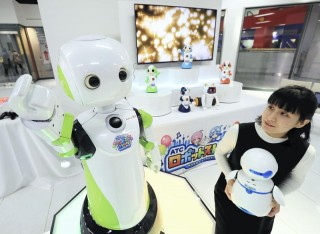Loading
Search
▼ Chinese-speaking Robots On Show at Osaka
- Category:Event
OSAKA — The Asia and Pacific Trade Center (ATC), which attracts foreigners visiting Japan from China and other countries, started a “Robot Street” event on Saturday at a commercial complex in Osaka.
“Bilingual” humanoid robots wait on customers at the event and answer questions in Japanese and Chinese, with some help from a human operator.
The humanoid robots at the event are not equipped with artificial intelligence, despite recent progress in the development of communication robots with AI. Instead, they provide customers with information about shops and other services based on preinstalled programs. For questions that can’t be answered through the programs, the robots provide answers with the help of a human operator.
The event is being held as an on-site experiment for the early realization of a society that makes better use of robots.
An average of 500 people, including Chinese, have visited the ATC each day since it opened a duty-free shop in July. The center planned the event to attract such foreign visitors to other areas, as many of them have not visited restaurants, event spaces and shops in the complex other than the duty-free shop.
Several robots are being used. A “robot concierge” stands in front of the duty-free shop, while a “robot clerk” waits on customers at a pop-up shop that sells robot-related products. The robot concierge can provide information on where visitors can find products and recommends shops by automatically giving preset answers.
The two robots speak Japanese and Chinese.
If a customer asks a question in Chinese that can’t be answered by the installed program, the robot translates it into Japanese for a human operator. After getting an answer from the operator in Japanese, the robot translates it into Chinese for the customer.
An engineer at Tokyo-based Tasukakeru Co. who is in charge of the event’s robotic system said the system is more realistic for practical use than AI communication robots when taking cost into account and that the system can facilitate humans and robots working together in the near future.
There are also two “information robots” that provide information about the event when people approach them, and three “stage robots” that dance to music. These robots all attend to visitors in some areas of the ATC.
The event utilizing robots as guides for foreign travelers has been selected as a Demonstration Project for Introduction of Robots by the Economy, Trade and Industry Ministry. The event will run through Jan. 31 next year. It is closed Dec. 28-31.
“Bilingual” humanoid robots wait on customers at the event and answer questions in Japanese and Chinese, with some help from a human operator.
The humanoid robots at the event are not equipped with artificial intelligence, despite recent progress in the development of communication robots with AI. Instead, they provide customers with information about shops and other services based on preinstalled programs. For questions that can’t be answered through the programs, the robots provide answers with the help of a human operator.
The event is being held as an on-site experiment for the early realization of a society that makes better use of robots.
An average of 500 people, including Chinese, have visited the ATC each day since it opened a duty-free shop in July. The center planned the event to attract such foreign visitors to other areas, as many of them have not visited restaurants, event spaces and shops in the complex other than the duty-free shop.
Several robots are being used. A “robot concierge” stands in front of the duty-free shop, while a “robot clerk” waits on customers at a pop-up shop that sells robot-related products. The robot concierge can provide information on where visitors can find products and recommends shops by automatically giving preset answers.
The two robots speak Japanese and Chinese.
If a customer asks a question in Chinese that can’t be answered by the installed program, the robot translates it into Japanese for a human operator. After getting an answer from the operator in Japanese, the robot translates it into Chinese for the customer.
An engineer at Tokyo-based Tasukakeru Co. who is in charge of the event’s robotic system said the system is more realistic for practical use than AI communication robots when taking cost into account and that the system can facilitate humans and robots working together in the near future.
There are also two “information robots” that provide information about the event when people approach them, and three “stage robots” that dance to music. These robots all attend to visitors in some areas of the ATC.
The event utilizing robots as guides for foreign travelers has been selected as a Demonstration Project for Introduction of Robots by the Economy, Trade and Industry Ministry. The event will run through Jan. 31 next year. It is closed Dec. 28-31.
- December 24, 2016
- Comment (0)
- Trackback(0)


